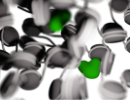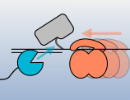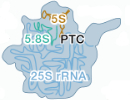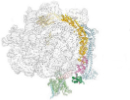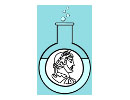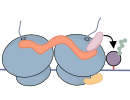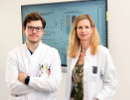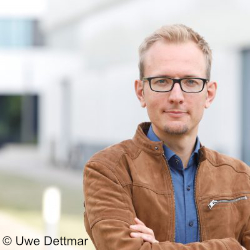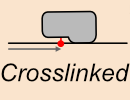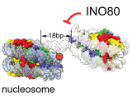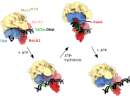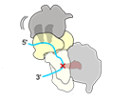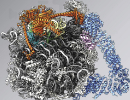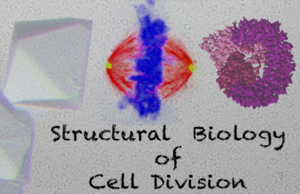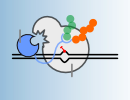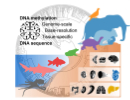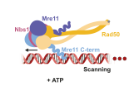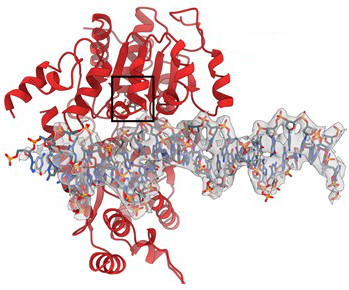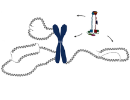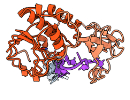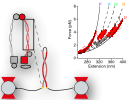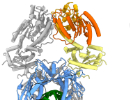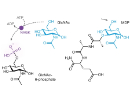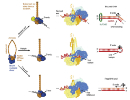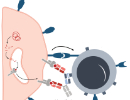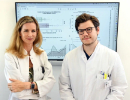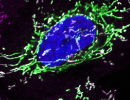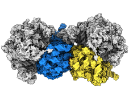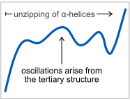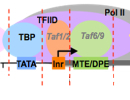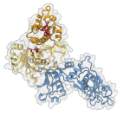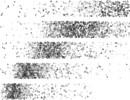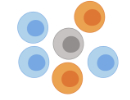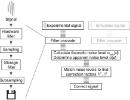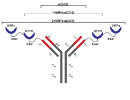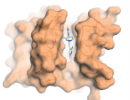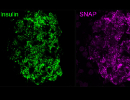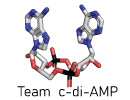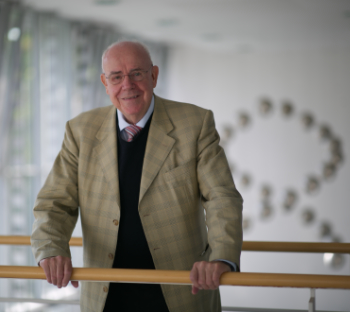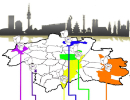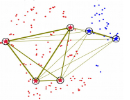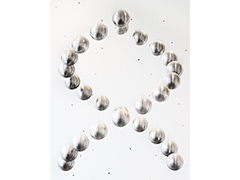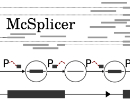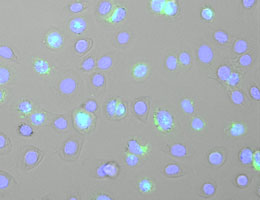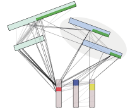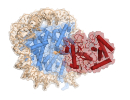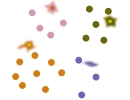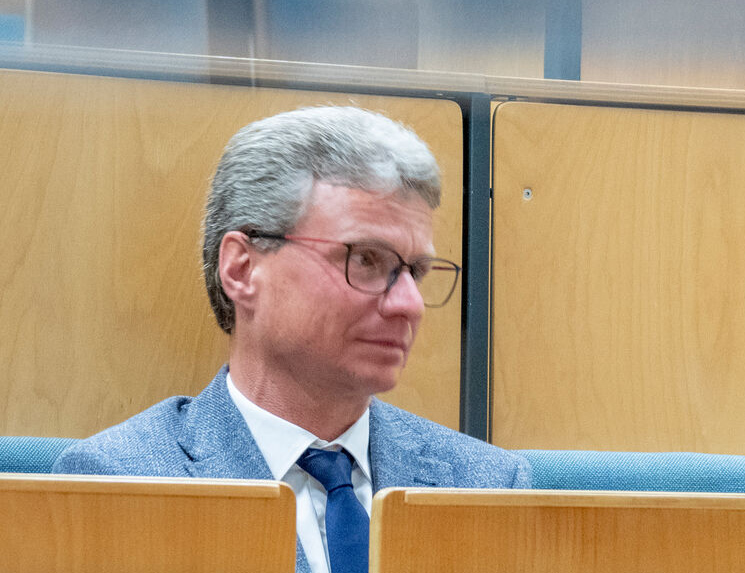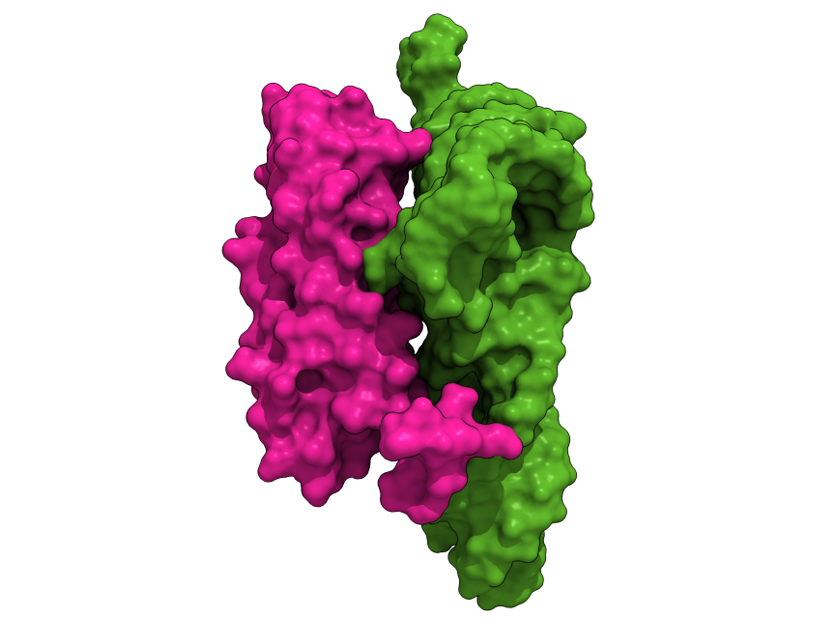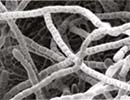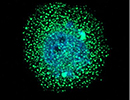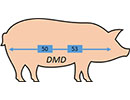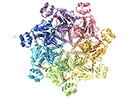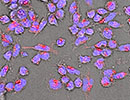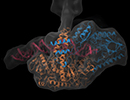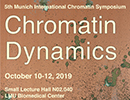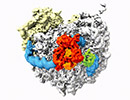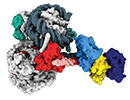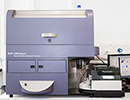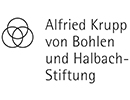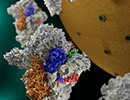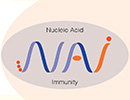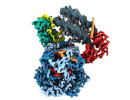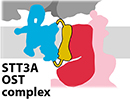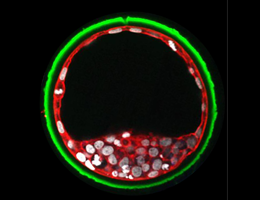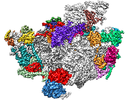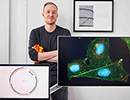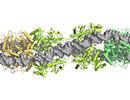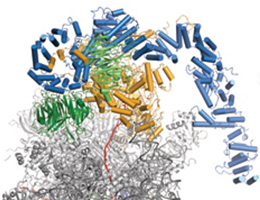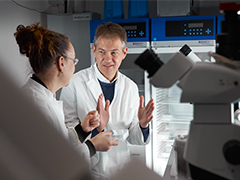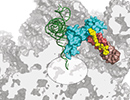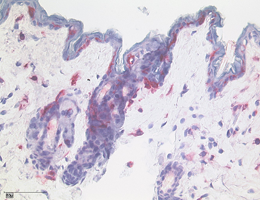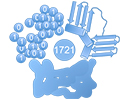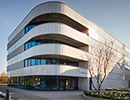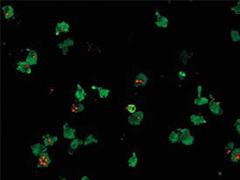Archive News
December 14, 2015
Römer Awards 2015
This year, Katharina Braunger, Stefan Arenz, Stephan Wickles, Lukas Bischoff and Agata Butryn from the Gene Center received Römer awards for their master/PhD theses. Since 2005 the Dr. Klaus Römer Foundation has been supporting research at the LMU Munich by awarding personal stipends to outstanding graduate students, postdocs and junior group leaders at the Departments of Biochemistry and Chemistry. With this year's Römer ceremony the Departments also celebrated the 10th anniversary of the foundation.
December 03, 2015
M4 Award for Nadja Fenn, Karl-Peter Hopfner and Marion Subklewe
Nadja Fenn, Karl-Peter Hopfner (Gene Center) and Marion Subklewe (University Hospital) have won one of five m4 Awards from the Bavarian Ministry of Economics for their project "A new antibody derivative that simultaneously targets tumor cells and locally inhibits immune checkpoints". M4 awards provide so-called “pre-seed” funding for academic biomedical research projects which show potential for business start-ups.
October 05, 2015
Veit Hornung arrives at the Gene Center
Veit Hornung, renowned immunologist and former director of the Institute of Molecular Medicine in Bonn, has been appointed Professor for Immunobiochemistry at the Department of Biochemistry. He has now started to move his research group to the Gene Center and is also setting up his recently awarded ERC Consolidator Grant at the LMU. The focus of Veit’s work is innate immunity, especially nucleic acid sensing and the inflammasome pathway.
August 13, 2015
Vallee Young Investigator Award for Fabiana Perocchi
Gene Center junior group leader Fabiana Perocchi is one of three recipients of the 2015 Vallee Young Investigator Award. The $250,000 Award donated by the Bert L and N Kuggie Vallee Foundation recognizes outstanding young scientists at a critical juncture in their careers in biomedical research. The grant will support Perocchi’s efforts to elucidate calcium mediated signaling networks in mitochondria.
March 31, 2015
Franz Herzog awarded Human Frontier Science Program Grant
Junior group leader Franz Herzog is part of an international team awarded a $ 900.000 research grant from the 2015 Human Frontier Science Program (HFSP), one of 31 proposals selected for funding from over one thousand applications. The proposed study “Molecular mechanisms of meiotic feedback regulation by the conserved chromosome axis” investigates chromosomal structures that are fundamental to sexual reproduction. The three-year project relies on the complementary expertise of the groups of Franz Herzog, Gene Center Munich, Attila Toth, TU Dresden Faculty of Medicine, and Kevin Corbett, Ludwig Institute for Cancer Research, La Jolla, USA. HFSP research grants are awarded for novel, ground-breaking collaborations involving extensive interaction between teams of researchers working in different disciplines and different countries.
February 24, 2015
BMBF-funded mitOmics consortium receives funding certificates from parliamentary state secretary Müller
On 9 February 2015, Julien Gagneur and his collaborators Tobias Haack and Fabiana Perocchi presented their BMBF-funded mitOmics project to MP Dr. Wolfgang Stefinger and the parliamentary state secretary of the Federal Ministry of Science and Education Stefan Müller during their visit to Munich. This collaborative project between the Gene Center and the HelmholtzZentrum München seeks to elucidate the genetic defects underlying rare mitochondrial disease. In a formal ceremony, state secretary Müller presented the scientists with their funding certificates.
February 02, 2015
Ralph Neumüller arrives at the Gene Center
Our new group leader Ralph Neumüller has just arrived at the Gene Center. His lab will be studying molecular mechanisms of cell growth regulation using a combination of genetics and systems biology approaches in Drosophila and mammalian cell culture systems.
December 22, 2014
Karl-Peter Hopfner receives Max Planck Society membership
The Max Planck Society has appointed Karl-Peter Hopfner as external scientific member of the Max Planck Institute of Biochemistry, Martinsried, in recognition of his outstanding work on the molecular mechanisms of genome maintenance.
December 09, 2014
ERC Starting Grant to Franz Herzog
Franz Herzog, leader of the junior research group “Biological Mass Spectrometry”, receives an ERC Starting Grant. The grant will support his studies on the structural reorganization of dividing cells and focuses on the assembly of the kinetochore.
December 05, 2014
Römer Ceremony 2014
Since 2005, the Dr. Klaus Römer Foundation has been supporting research at the LMU Munich by awarding personal stipends to outstanding graduate students, postdocs and junior group leaders at the Departments of Biochemistry and Chemistry. This year, Carlo Bäjen, Sebastian Kube, Mirela Marasovic, Florian Schlauderer and Amelie Schreieck from the Gene Center received awards for their PhD theses.
November 17, 2014
Care-for-Rare Science Award to Petra Wendler
Petra Wendler received the 2014 Care-for-Rare Science Award for her project on peroxisome biogenesis disorders. The prize honors outstanding research projects in the area of rare diseases affecting children and is endowed with €50,000 start-up funding for new scientific projects.
October 30, 2014
BMBF funding for Julian Gagneur and Fabiana Perocchi
Together with Tobias Haack from the Helmholtz Zentrum München, Gene Center junior group leaders Julien Gagneur and Fabiana Perocchi have set up „mitOmics“, an initiative that – by analyzing genomes of patients with mitochondral disorders– proposes to identify disfunctional signaling pathways as well as the underlying mutations. The consortium is coordinated by computational biologist Julien Gagneur.
October 22, 2014
Official inauguration of the Graduate School of Quantitative Biosciences (QBM)
On October 20, 2014, we celebrated the official inauguration of the QBM Graduate School. LMU President Bernd Huber, Ulrich Hörlein from the Bavarian State Ministry for Science and Education, and the Speaker of QBM, Ulrike Gaul, welcomed the 200 guests. Renowned scientists from the range of disciplines represented in the School spoke about their latest work, among them QBM scientific advisory board members Naama Barkai (Weizmann Institute), Jean-Francois Joanny (Institute Curie), Rachel Green (Johns Hopkins University) and Wolfgang Huber (EMBL). The Emflosaji Quartet (winner of "Jugend musiziert") provided a stimulating musical interlude and the second-year QBM students presented and discussed their research in a poster session. Festivities concluded with dinner and a party. Impressions: http://www.qbm.genzentrum.lmu.de/impressions/
October 10, 2014
New insights into the bacterial reaction to Erythromycin
In a recent study, Daniel Wilson shows structural changes in the bacterial ribosome that occur with resistance to the antibiotic Erythromycin. They are imaged at extremely high resolution with the help of cryo-electron microscopy. (Molecular Cell 56: 446-452, 2014)
September 26, 2014
Farewell Party for Patrick Cramer
Patrick Cramer is leaving the Gene Center for the Max Planck Institute for Biophysical Chemistry in Göttingen. On September 26, we celebrated his outstanding achievements in science and science policy, which will have a lasting influence on the Gene Center and on research in Bavaria. In addition to the farewell lecture by Patrick Cramer, contributions were made by LMU president Bernd Huber, Eckhard Wolf, Karl-Peter Hopfner and Ernst-Ludwig Winnacker.
July 01, 2014
Karl-Peter Hopfner elected to Leopoldina
The German National Academy of Sciences Leopoldina has elected Karl-Peter Hopfner as a new member of its Biochemistry and Biophysics section. The Leopoldina was founded in 1652 and honors researchers for their outstanding scientific contributions.
June 20, 2014
Structure of the Vibrio cholerae type VI secretion system
In a recent study, Petra Wendler and her team have investigated one of the special transport systems that bacteria use to deliver toxic proteins into host cells or competing bacteria, the type VI secretion system. The group took a closer look at a contractile tubular protein complex from the Vibrio cholerae system that was recently shown to expel pathogenic effecors. By determining the 6 Å cryoelectron microscopy structure of the contracted tubule consisting of the proteins VipA and VipB, Wendler and colleagues identified structural homology between the C-terminal segment of VipB and the tail-sheath protein of T4 phages. (Cell Reports Volume 8, Issue 1, p 20–30, 10 July 2014)
September 01, 2012
Three new group leaders at the Gene Center
Three young scientists, Fabiana Perocchi, Franz Herzog, and Julien Gagneur have set up their labs at the Gene Center. Perocchi, who is funded by the Bavarian Research Network for Molecular Biosystems (BaySysNet) and by the Emmy Noether Program of the DFG, studies mitochondrial signaling networks using functional genomics. Herzog uses mass spectrometry to investigate the protein complexes responsible for the structural changes cells undergo during the cell cycle. Gagneur is a computational biologist who develops statistical and mathematical methods to understand genetic variation and gene regulation at genome-scale.
August 28, 2012
ERC Starting Grant to Mario Halic
Mario Halic receives an ERC Starting Grant, a highly endowed (€ 1.5 M for 5 years) and prestigious award for researchers in the early phase of their independent careers. The grant will support Halic's efforts to understand how priRNAs are generated within the cell and how they function in gene regulation and DNA packaging.
July 31, 2012
DNA damage sends small RNA signal
In a recent study, Klaus Förstemann’s group could show that double strand breaks in the DNA result in the production of small interfering RNAs (siRNAs). The researchers could show that the siRNAs all derive from the region between promoter and double strand break and are used to inactivate the faulty transcript. Nucleic Acids Research, July 30, 2012.
June 22, 2012
In pursuit of pathogenic factors
In a recent study, Daniel Wilson’s group has identified the elusive factor that makes certain pathogenic bacteria more potent. The pathogenicity of these bacteria is strongly increased by the enzyme YfcM, which modifies a universal translation elongation factor, EF-P. Due to its unique character, YfcM might prove an ideal target for the much-needed development of novel antibiotics. Nature Chemical Biology, June 17, 2012.
June 19, 2012
Structure of DNA repair factor identified
In a recent study, Karl-Peter Hopfner’s group has discovered the molecular mechanism underlying ATLD, an inherited neurodegenerative disease. The ATLD mutation affects the DNA repair complex MRN, which consists of the nuclease Mre11, the ATPase Rad50 and the regulatory protein Nbs1. The researchers could show that the mutation destabilizes the interaction between Mre11 and Nbs1 and thereby impairs the activation of the ATM protein, which is a central player in the repair of DNA damage. Nature Structural and Molecular Biology, June 18, 2012.
June 15, 2012
Excellence day at LMU Munich
Today, LMU Munich emerged as the most successful German university in the second round of the Excellence Initiative. All of its nine proposals – four graduate schools, four research clusters and the University’s overall strategic concept – were selected for funding. In the life sciences, the two clusters CIPSM and SyNergy will support research in protein science and neurodegenerative diseases, the two graduate schools GSN and QBM will promote education in neuroscience and quantitative bioscience. Gene Center scientists are strongly represented in both CIPSM and in the newly founded graduate school QBM, which will be coordinated by Ulrike Gaul (www.qbm.lmu.de).
June 01, 2012
Diabetes – alarm signals in the blood
In a recent study, Eckhard Wolf’s group developed a transgenic pig that models the pre-diabetic phase of the disease. In collaboration with the Helmholtz Center Munich, the scientists identified biomarkers whose concentration in the blood correlates with the mass of insulin-producing cells in the pancreas; they can therefore serve as indicators to facilitate the early diagnosis of diabetes. Diabetes online April 2012.
May 14, 2012
First BioSysNet Meeting at the LMU Gene Center
The new Bavarian Research Network for Molecular Biosystems (BioSysNet) held its inaugural symposium at the Gene Center today. Following welcoming remarks by Science Minister Dr. Wolfgang Heubisch, the participating researchers publicly presented their projects for the first time. Within the network, 25 research groups led by junior or senior investigators will receive funding for five years by the Bavarian State Ministry of Science, Research and Arts. Among these are ten research teams from the LMU, covering a wide range of topics – from gene regulation to diabetes and viral infections.
May 09, 2012
Ulrike Gaul elected to EMBO
Ulrike Gaul has been elected member of the European Molecular Biology Organization (EMBO) in recognition of her pioneering work in developmental systems biology.
April 17, 2012
Patrick Cramer receives Federal Order of Merit
Patrick Cramer received the Federal Order of Merit (Bundesverdienstkreuz am Bande des Verdienstordens der Bundesrepublik Deutschland) for his groundbreaking work on transcription. The Director of the Gene Center was also honored for his sustained and manifold contributions to strengthening Munich’s profile within the German and European scientific landscape.
February 23, 2012
Cells practice sustainability – conserved mechanism of ribosomal recycling
In a recent study, Roland Beckmann’s group has investigated the recycling of ribosomes, a key phase in ribosome-driven protein biosynthesis. For the first time, the researchers were able to visualize the binding of a key enzyme, the ATPase ABCE1, to the ribosome in eukaryotes as well as archeae. Based on their structural analysis, they propose a conserved mechanism that couples translation termination to recycling and a new round of synthesis. Nature online February 23, 2012
January 05, 2012
BioSysNet funds four new junior research groups in Systems Biology
The Bavarian State Ministry of Sciences has announced funding for four independent junior research groups to inaugurate the new Bavarian Research Network for Molecular Biosystems (BioSysNet). Each group will receive 1.5 M € over a 5 year period.
December 27, 2011
Improved algorithm for sequence analysis of proteins
In a recent study, Johannes Söding’s group has introduced a new computer algorithm, HHblits, which detects sequence similarities in proteins much better and faster than the commonly used PSI-BLAST. Nature Methods December 25, 2011.
November 16, 2011
Beckmann receives ERC Advanced Investigator Grant
Roland Beckmann received an Advanced Investigator Grant from the European Research Council. These lucrative and highly competitive grants are awarded to European researchers based on their outstanding scientific achievements and designed to support highly innovative research. Professor Beckmann’s ERC project is aimed at improving the resolution of cryo-EM in order to investigate how membrane proteins are inserted into the membrane during translation.
October 13, 2011
Wolf among the most highly cited reproduction biologists
Eckhard Wolf is the second-most highly cited reproduction biologist in Germany, Austria and Switzerland, according to an analysis by the monthly ‘Laborjournal’ (www.laborjournal.de).
September 26, 2011
How genes are transcribed in mitochondria
In a recent study, Patrick Cramer’s group, in collaboration with Dmitry Temiakov at UMDNJ, has described the first three-dimensional structure of the human mitochondrial RNA-polymerase. Interestingly, the structure shows similarity to RNA polymerases of bacteriophages, concordant with the now widely accepted idea that mitochondria are derived from endosymbiotic bacteria. Nature online September 25, 2011 doi:10.1038
July 18, 2011
m4 award to LMU and University of Erlangen teams for leukemia research
Karl-Peter Hopfner, together with Fuat Oduncu (Medical Clinic, LMU) and Georg Fey (Friedrich-Alexander-University Erlangen), received an m4 award in the amount of €500,000 for their proposal to develop antibody derivatives for personalized therapy of acute myeloid leukemia. The m4 award is financed by the Bavarian Ministry of Economy and the Federal Ministry of Education and Research, and provides start-up funding for projects with high commercial potential.
July 07, 2011
Molecular corkscrew knows the drill
In a recent study, Karl-Peter Hopfner's group has investigated how Swi2/Snf2 remodelers modulate protein-DNA interactions. They analyzed the structure and function of Modifier of Transcription 1 (Mot1), a simple member of this remodeler family. Mot1 winds along the DNA like a corkscrew, thereby replacing one of the key regulatory proteins, the TATA box binding protein (TBP), from the DNA. While this stops transcription of the target gene, TBP is stabilized and redistributed to other genes in the genome (Nature Advance Online Publication, July 6, 2011; Doi: 10.1038/nature10215)
June 21, 2011
How to make stripes
Recent research from Ulrike Gaul's lab sheds new light on how periodicity is generated in animal body plans. Using a combination of computational and experimental approaches, the scientists examine the complex transcriptional regulation that underlies the formation of the 7-stripe expression patterns of pair-rule genes in Drosophila segmentation. They identify multiple new cis-regulatory elements and show that the non-periodically expressed maternal and gap genes have a much more pervasive role in setting up pair rule gene stripes than previously thought (Development 138, 3067-78).
June 09, 2011
When ribosomes get stuck - watching the demise of defect mRNAs
A recent study by Roland Beckmann's group provided new insight into the demise of mRNAs stalled on ribosomes, a process called Nogo decay and mediated by the factors Dom34 and Hbs1. Using cryo electron microscopy, they visualized a stalled complex and could demonstrate that Dom34/Hbs1 destabilize the complex, leading to the disassembly of the entire complex or the selective removal and degradation of the mRNA. Since the nature of the mRNA defect appears to be irrelevant, Nogo decay may serve to rescue blocked ribosomes more generally (Nature Structural & Molecular Biology 18, 715-720).
May 18, 2011
Protein complex Prp19 plays dual role in control of gene expression
New research from Katja Strässer's group shows how the TREX complex, which couples transcription of mRNAs to their export into the cytoplasm, is recruited to actively transcribed genes. They could demonstrate that the protein complex Prp19, previously only thought to be involved in splicing of pre-mRNAs, interacts with both RNA-Polymerase II, the enzyme which synthesizes mRNA, and TREX, which mediates mRNA transport (Genes Dev May 16, 2011 doi: 10.1101)
April 20, 2011
How molecules find the right place at the right time
In a recent study, Dierck Niessing's group made an important contribution to understanding the underlying principles of messenger RNA transport within the cell. Using a combination of biochemical, biophysical and in vivo methods, they could show that mRNAs destined for transport form a tight complex, first with the RNA- binding protein She2p within the nucleus and, after nuclear export, with the cytoplasmic adapter protein She3p. She3p binds both She2p and mRNA and connects them with the motor protein Myo4p (PloS Biology 9: e 1000611).
April 18, 2011
How proteins are integrated into the plasma membrane – a 3D view
In a recent study, Roland Beckmann’s group introduces a new method by which the integration of proteins into membranes can be investigated. During translation, ribosomes settle on a membrane-spanning channel into which they thread the nascent protein. The researchers could show, for the first time, that the channel releases the protein into the membrane through a lateral opening (Nat Struct and Mol Biol Apr 17. [Epub ahead of print]
April 01, 2011
Solving the crystal structure of a key factor in DNA repair
The most dangerous damage to genomic DNA are double strand breaks. In a recent study, Karl-Peter Hopfner’s group has solved the crystal structure of the MR complex, which plays a central role in recognizing these break, and has obtained intriguing insight into the recognition process. The complex initially has an open structure which closes, in an ATP-dependent fashion, when encountering a double strand break. End-to-end interactions between MR complexes prevent the DNA ends from drifting apart (Cell 145:54-66).
February 24, 2011
How cells overcome transcription blockage
In a recent study, Patrick Cramer’s group unravels the structural basis of RNA Polymerase II backtracking, arrest and reactivation (Nature 471:249-43).
January 26, 2011
Viruses spoiling their hosts’ innate immune response
Co-evolution with their hosts made viruses experts in manipulating the immune system of their hosts. In two recent studies, the group of Karl-Klaus Conzelmann elucidates key mechanisms of immune evasion by two different ...
Co-evolution with their hosts made viruses experts in manipulating the immune system of their hosts. In two recent studies, the group of Karl-Klaus Conzelmann elucidates key mechanisms of immune evasion by two different viruses, the neurotropic rabies virus and the haematotropic measles virus. While the rabies virus simply counteracts expression and function of interferon, a powerful antiviral and immune-stimulatory cytokine, the measles virus also interferes with the activity of the transcription factor NF-kB, which governs both innate immune responses and differentiation of immune cells (J Virol XXX, 2011; J Virol 85: 842-52).
January 04, 2011
Dynamic transcriptome analysis measures mRNA turnover
In a recent study, Achim Tresch’s and Patrick Cramer’s groups have collaboratively developed a novel method, dynamic transcriptome analysis, to determine messenger RNA synthesis and decay rates on a genome-wide level. Using metabolic labeling of newly synthesized messenger RNA, followed by careful statistical modeling, they achieve a higher sensitivity and better temporal resolution than previous methods. Applying this new approach to yeast, they find that, under normal growth conditions, mRNA transcription and degradation are uncoupled, yet become coupled under osmotic stress (Molecular Systems Biology 7: 458, 2011).
December 16, 2010
MP Seehofer signs off on funding for systems biology
Bavarian Minister President Seehofer and the State Parliament passed the state budget for the coming 2 years, which commits 13.6 Mio € to establish the new Research Center for Molecular Biosystems and 18.1 Mio € to the BaySys research network, which is designed to support biosystems science in Bavaria. Gene Center scientists play a leading role in both initiatives.
December 14, 2010
Cramer receives ERC Advanced Investigator Grant
Patrick Cramer has received an Advanced Investigator Grant from the European Research Council. These lucrative and highly competitive grants are awarded to European researchers based on their outstanding scientific achievements to support highly innovative research. Professor Cramer’s project is entitled: ‘Mechanisms of regulated transcription initiation’.
December 02, 2010
How tRNAs move through the ribosome during translation
During translation, tRNAs move through the ribosome by a process called translocation, which is catalyzed by the elongation factor EF-G. By utilizing the antibiotic fusidic acid, a recent study by Daniel Wilson’s group traps EF-G on the ribosome in different intermediate states of translocation, providing insight into how the tRNAs move through the ribosome (Nature 468: 713-6, 2010).
November 23, 2010
Wilson receives EMBO Young Investigator Award
Daniel Wilson has been honored with the prestigious EMBO Young Investigator Award for his work to improve the design of antibiotics based on the structural analysis of bacterial ribosomes.
November 19, 2010
Transcription factor implicated in DNA repair
In a recent study, Katja Strässer’s group showed that the transcription factor Bur1-Bur2, which is known to interact with a protein complex that couples transcription with RNA export (TREX), also plays a role in DNA repair. The researchers demonstrate that Bur1-Bur2 interacts with the replication protein A and thus maintains genome stability during replication (J Biol Chem 285:41665-74, 2010).
October 27, 2010
Beckmann and Hopfner become EMBO Members
Professors Karl-Peter Hopfner and Roland Beckmann have been elected EMBO members for their outstanding work on the molecular mechanisms of genome maintenance and protein translation, respectively.
October 08, 2010
Protein synthesis can be blocked specifically
Translation of particular polypeptide chains leads to translational stalling, which is used by eukaryotes to repress the translation of downstream genes. In a recent study by Roland Beckmann’s and Daniel Wilson’s groups, cryo-electron microscopy reconstructions of two nascent peptide-stalled eukaryotic ribosomes reveal contacts with the ribosomal tunnel, and provide evidence for compaction of the nascent chain within defined regions of the tunnel (Mol Cell 40: 138-46, 2010).
October 01, 2010
How tRNA production is turned off
In a recent study, Patrick Cramer’s group has elucidated how one of the key engines of gene expression, RNA polymerase III, is inhibited when cells are under stress. Using a combination of structural biology and biochemistry, they demonstrate that, under stress conditions, the inhibitor Maf1 binds to the surface of the polymerase and prevents the formation of an active transcription initiation complex at the promoter (Cell 143:59-70, 2010).
September 28, 2010
Beckmann elected to Leopoldina
The German Academy of Natural Scientists Leopoldina has elected Professor Roland Beckmann as a new member of its Biochemistry and Biophysics section. The Leopoldina was founded in 1652 and honors researchers for their outstanding scientific contributions.
July 05, 2010
Federal Funding secured for BioSysM Research Building
The German Science Council (Wissenschaftsrat) has recommended funding the construction of a new research building ‘Molecular Biosystems Munich’ on the life sciences campus Großhadern/Martinsried. This new building seeks to gather the expertise of different disciplines under one roof to study complex biological systems in their entirety.
May 28, 2010
New insights into the function of antibiotics
Macrolide antibiotics bind within the ribosomal tunnel and prevent elongation of the nascent polypeptide chain. In a recent study, Daniel Wilson’s group provides evidence that the sequence of the polypeptide influences the efficacy of the inhibitory activity of the antibiotic, suggesting that macrolide antibiotics do not act on all translating ribosomes equally (Chem Biol 17: 504-14, 2010).
May 25, 2010
Protein linking the most important steps in gene expression
In a recent publication, Katja Strässer’s group has studied the RNA binding protein Sro 9, which was known to play a complex role in gene expression. They demonstrated that Sro9 is recruited to actively transcribed genes in the nucleus and shuttles between nucleus and cytoplasm, suggesting that the protein accompanies mRNAs throughout their life, thereby increasing their perdurance and the efficiency of translation (RNA 16: 1393-401, 2010).
February 07, 2010
Ribosomal tunnel restricts α-helix formation to exit
In a recent study, Roland Beckmann’s group visualizes the nascent polypeptide chains with high α-helical propensity within the ribosomal tunnel. Interestingly, helix formation appears to be restricted to defined regions of the ribosomal tunnel, particularly the region directly adjacent to the tunnel exit (Nat Struct Mol Biol 17:313-7, 2010).
January 27, 2010
Evolution of bacterial outer membrane proteins
In a recent study, Johannes Söding’s group reconstructed the evolutionary origin of the main class of bacterial outer membrane proteins. By applying various advanced sequence search methods developed by the authors, they show that, several billion years ago, bacterial outer membrane beta barrels evolved from a single beta-beta hairpin structure by amplification and diversification. This result provides the basis for improved methods to detect this important class of bacterial antigens and virulence factors (Mol Biol Evol 27:1348-1358, 2010).
January 17, 2010
Nanobodies change the form and function of proteins
In a recent collaborative study, Karl-Peter Hopfner’s group has shown that nanobodies, small single domain antibodies, modulate the conformation and spectral properties of GFP. Through subtle changes in the chromophore environment GFP fluorescence can be reduced or increased. Since nanobodies are active in living cells, they may become excellent tools to expand GFP’s functional repertoire (Nat Struct Mol Biol 17: 133-8).
December 04, 2009
Caught in translation
In a recent double feature, Roland Beckmann’s group has studied different aspects of nascent translation. In all organisms, the translation of secretory and membrane proteins can be directly coupled to the translocation across or insertion into membranes. Their first study visualizes the translation machinery interacting with a single copy of the protein-conducting channel, the Sec61 complex. (Science 326:1369-73, 2009). As polypeptide chains are synthesized, they pass through a tunnel on the large ribosomal subunit. In their second study, interaction of the bacterial TnaC polypeptide chain with components of the ribosomal tunnel are visualized using cryo-electron microscopy, providing insight into the mechanism of translational stalling (Science 326:1412-5, 2009).
October 30, 2009
Novel antibiotic lead compounds identified
The emergence of multi-drug resistant bacterial strains underscores the urgent need for the development of novel antimicrobial agents. In a recent study by Daniel Wilson’s group, a variety of high-throughput translation machinery assays are utilized to identify novel antibiotic-precursor lead compounds (Chem Biol 16: 1087-96, 2009).
October 23, 2009
New protein structure involved in neurodegeneration
In a recent publication, Dierk Niessing’s group has solved the x-ray structure of Pur-alpha, a protein which binds to CGG repeats in messenger RNA and is a key factor in fragile X-Syndrome, one of the most common genet...
October 09, 2009
Finding the transcription start site of a gene
In a recent study, Patrick Cramer’s group has developed a model for transcription initiation from the promoter of a protein-coding gene in yeast. Using a combination of structural biology, biochemistry and genetics, they elucidate the mechanisms by which the transcription machinery binds to the promoter, opens the DNA and locates the start site for messenger RNA synthesis (Nature 462: 323-330, 2009).
October 07, 2009
Small RNAs keep selfish genetic elements under control
Control of selfish genetic elements is essential in the germline, however, their activity has to be restrained in somatic cells also. In Drosophila, a small RNA-based ‘immune system’ called endo-siRNAs is in charge of this somatic counter-attack. In a recent study, Klaus Förstemann’s group has identified an essential component of endo-siRNA biogenesis and proposes a new mechanism by which cells define the sequences that have to be silenced (EMBO J 28: 2933-44, 2009).
October 01, 2009
Petra Wendler arrives at the Gene Center
Petra Wendler, a Fellow of the Emmy Noether Program of the DFG, has just arrived at the Gene Center. Her lab will be studying the mechanisms of force generation in molecular motor proteins of the AAA+ family, such as the 19S proteasomal base. Wendler uses a range of biochemical and structural approaches, including single particle cryo-EM.
July 29, 2009
microRNA has multiple roles in germline development
In a recent study, Ulrike Gaul’s group has shown a surprisingly broad role for a single microRNA, miR-184, in flies. They find that miR-184 is required maternally for stem cell differentiation in the ovaries, as well as for axis formation in the egg chamber and the developing embryo. Intriguingly, the transcripts targeted by miR-184 in these processes encode regulatory factors rather than key pathway inducers or morphogens, suggesting that in this context miR-184 may serve to tune rather than direct development (Dev Cell 17:123-33, 2009).
June 01, 2009
Gaul lab arrives at the Gene Center
Ulrike Gaul, recipient of an Alexander von Humboldt Professorship in 2008 and newly appointed Professor of Organismic Biochemistry at the Department of Biochemistry, arrives at the Gene Center with her group – and a few thousand Drosophila strains in tow. Her lab seeks to combine molecular, genetic, genomic, and computational approaches to achieve a systems-level understanding of biological processes, with special focus on two problems: the regulatory gene networks underlying cell fating and differentiation during development, and the role of glia in the development and homeostasis of the nervous system.
April 10, 2009
Protein disaggregase Hsp104 on the move
In a recent study, Petra Wendler’s group presents cryo EM reconstructions of the protein remodeling complex Hsp104 in different functional states. The structures reveal large, nucleotide-dependent domain rearrangements which suggest substrate threading along the central axis of the complex. These results support a model of sequential ATP firing of the ATPase domains within the ring rather than a concerted action (Mol Cell 34: 81-92, 2009).
February 23, 2009
Improved sequence analysis of genes and proteins
In a recent study, Johannes Söding’s group has introduced a novel computational method for finding remote homologies in protein and DNA sequences. Their algorithm searches sequences databases at the same speed as others, such as BLAST, but is much more sensitive in picking up conserved features (PNAS 106: 3770-5, 2009).
February 20, 2009
How human cells sense RNA viral infections
How human cells distinguish between invading viral RNA and their own cytoplasmic messenger RNA is not well understood. In a recent collaborative study, Karl-Peter Hopfner’s group has shown that the cytosolic multidomain protein RIG-I senses two important viral RNA patterns - long double strands and 5’ phosphates – and stimulate its ATPase and downstream signaling activity, in turn eliciting an antiviral innate immune response (Science 323: 1070-4, 2010).
January 08, 2009
Cramer receives Ernst-Jung Research Award
Patrick Cramer receives the Ernst-Jung Research Award for his outstanding work on transcription. This annual Prize was established in 1967 by the Hamburg merchant Ernst Jung and is awarded for ground-breaking medical research.











